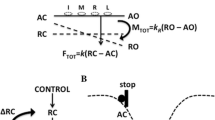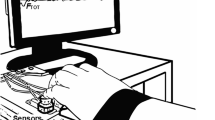Abstract
We address the nature of unintentional changes in performance in two papers. This second paper tested hypotheses related to stability of task-specific performance variables estimated using the framework of the uncontrolled manifold (UCM) hypothesis. Our first hypothesis was that selective stability of performance variables would be observed even when the magnitudes of those variables drifted unintentionally because of the lack of visual feedback. Our second hypothesis was that stability of a variable would depend on the number of explicit task constraints. Subjects performed four-finger isometric pressing tasks that required the accurate production of a combination of total moment and total force with natural or modified finger involvement under full visual feedback, which was removed later for some or all of the salient variables. We used inter-trial analysis of variance and drifts in the space of finger forces within the UCM and within the orthogonal to the UCM space. The two variance components were used to estimate a synergy index stabilizing the force/moment combination, while the two drift components were used to estimate motor equivalent and non-motor equivalent force changes, respectively. Without visual feedback, both force and moment drifted toward lower absolute magnitudes. The non-motor equivalent component of motion in the finger force space was larger than the motor equivalent component for variables that stopped receiving visual feedback. In contrast, variables that continued to receive visual feedback showed larger motor equivalent component, compared to non-motor equivalent component, over the same time interval. These data falsified the first hypothesis; indeed, selective stabilization of a variable over the duration of a trial allows expecting comparably large motor equivalent components both with and without visual feedback. Adding a new constraint (presented as a target magnitude of middle finger force) resulted in a drop in the synergy index in support of the second hypothesis. We interpret the force drift as a natural relaxation process toward states with lower potential energy in the physical (physiological) system involved in the task. The results show that presenting sensory feedback on a performance variable makes synergies stabilizing that variable dependent on that particular sensory feedback.






Similar content being viewed by others
References
Ambike S, Zatsiorsky VM, Latash ML (2015) Processes underlying unintentional finger force changes in the absence of visual feedback. Exp Brain Res 233:711–721
Ambike S, Mattos D, Zatsiorsky VM, Latash ML (2016) Unsteady steady-states: central causes of unintentional force drift. Exp Brain Res (in press)
Babinski F (1899) De l’asynergie cerebelleuse. Rev Neurol 7:806–816
Bernstein NA (1947) On the construction of movements. Medgiz, Moscow (in Russian)
Bernstein NA (1967) The co-ordination and regulation of movements. Pergamon Press, Oxford
d’Avella A, Saltiel P, Bizzi E (2003) Combinations of muscle synergies in the construction of a natural motor behavior. Nat Neurosci 6:300–308
DeWald JP, Pope PS, Given JD, Buchanan TS, Rymer WZ (1995) Abnormal muscle coactivation patterns during isometric torque generation at the elbow and shoulder in hemiparetic subjects. Brain 118:495–510
Diedrichsen J (2007) Optimal task-dependent changes of bimanual feedback control and adaptation. Curr Biol 17:1675–1679
Diedrichsen J, Shadmehr R, Ivry RB (2010) The coordination of movement: optimal feedback control and beyond. Trends Cogn Sci 14:31–39
Feldman AG (2015) Referent control of action and perception: challenging conventional theories in behavioral science. Springer, New York
Gelfand IM, Latash ML (1998) On the problem of adequate language in movement science. Mot Control 2:306–313
Hammond PH (1954) Involuntary activity in biceps following the sudden application of velocity to the abducted forearm. J Physiol 127:23P–25P
Harris CM, Wolpert DM (1998) Signal-dependent noise determines motor planning. Nature 394:780–784
Ivanenko YP, Poppele RE, Lacquaniti F (2004) Five basic muscle activation patterns account for muscle activity during human locomotion. J Physiol 556:267–282
Jo HJ, Maenza C, Good DC, Huang X, Park J, Sainburg RL, Latash ML (2016) Effects of unilateral stroke on multi-finger synergies and their feed-forward adjustments. Neuroscience 319:194–205
Kugler PN, Turvey MT (1987) Information, natural law, and the self-assembly of rhythmic movement. Erlbaum, Hillsdale
Latash ML (2008) Synergy. Oxford University Press, New York
Latash ML (2010) Motor synergies and the equilibrium-point hypothesis. Mot Control 14:294–322
Latash ML (2012) The bliss (not the problem) of motor abundance (not redundancy). Exp Brain Res 217:1–5
Latash ML (2016) Towards physics of neural processes and behavior. Neurosci Biobehav Rev 69:136–146
Latash ML, Huang X (2015) Neural control of movement stability: lessons from studies of neurological patients. Neuroscience 301:39–48
Latash ML, Zatsiorsky VM (2016) Biomechanics and motor control: defining central concepts. Academic Press, New York
Latash ML, Scholz JF, Danion F, Schöner G (2001) Structure of motor variability in marginally redundant multi-finger force production tasks. Exp Brain Res 141:153–165
Latash ML, Scholz JP, Schöner G (2002) Motor control strategies revealed in the structure of motor variability. Exerc Sport Sci Rev 30:26–31
Latash ML, Shim JK, Smilga AV, Zatsiorsky V (2005) A central back-coupling hypothesis on the organization of motor synergies: a physical metaphor and a neural model. Biol Cybern 92:186–191
Latash ML, Scholz JP, Schöner G (2007) Toward a new theory of motor synergies. Mot Control 11:276–308
Latash ML, Levin MF, Scholz JP, Schöner G (2010) Motor control theories and their applications. Medicina 46:382–392
Martin V, Scholz JP, Schöner G (2009) Redundancy, self-motion, and motor control. Neural Comput 21:1371–1414
Mattos D, Latash ML, Park E, Kuhl J, Scholz JP (2011) Unpredictable elbow joint perturbation during reaching results in multijoint motor equivalence. J Neurophysiol 106:1424–1436
Mattos D, Kuhl J, Scholz JP, Latash ML (2013) Motor equivalence (ME) during reaching: is ME observable at the muscle level? Mot Control 17:145–175
Mattos D, Schöner G, Zatsiorsky VM, Latash ML (2015) Motor equivalence during accurate multi-finger force production. Exp Brain Res 233:487–502
Newell KM, Carlton LG (1993) Force variability in isometric responses. J Exp Psychol Hum Percept Perform 14:37–44
Olafsdottir H, Yoshida N, Zatsiorsky VM, Latash ML (2005) Anticipatory covariation of finger forces during self-paced and reaction time force production. Neurosci Lett 381:92–96
Park J, Zatsiorsky VM, Latash ML (2010) Optimality vs. variability: An example of multi-finger redundant tasks. Exp Brain Res 207:119–132
Park J, Wu Y-H, Lewis MM, Huang X, Latash ML (2012) Changes in multi-finger interaction and coordination in Parkinson’s disease. J Neurophysiol 108:915–924
Parsa B, O’Shea DJ, Zatsiorsky VM, Latash ML (2016) On the nature of unintentional action: a study of force/moment drifts during multi-finger tasks. J Neurophysiol 116:698–708
Parsa B, Terekhov A, Zatsiorsky VM, Latash ML (2017) Optimality and stability of intentional and unintentional actions: I. Origins of drifts in performance. Exp Brain Res (the companion paper)
Ranganathan R, Newell KM (2008) Motor synergies: feedback and error compensation within and between trials. Exp Brain Res 186:561–570
Ranganathan R, Newell KM (2009) Influence of augmented feedback on coordination strategies. J Mot Behav 41:317–330
Scholz JP, Schöner G (1999) The uncontrolled manifold concept: identifying control variables for a functional task. Exp Brain Res 126:289–306
Scholz JP, Schöner G (2014) Use of the uncontrolled manifold (UCM) approach to understand motor variability, motor equivalence, and self-motion. Adv Exp Med Biol 826:91–100
Scholz JP, Schöner G, Latash ML (2000) Identifying the control structure of multijoint coordination during pistol shooting. Exp Brain Res 135:382–404
Scholz JP, Danion F, Latash ML, Schöner G (2002) Understanding finger coordination through analysis of the structure of force variability. Biol Cybern 86:29–39
Scholz JP, Dwight-Higgin T, Lynch JE, Tseng YW, Martin V, Schöner G (2011) Motor equivalence and self-motion induced by different movement speeds. Exp Brain Res 209:319–332
Schöner G (1995) Recent developments and problems in human movement science and their conceptual implications. Ecol Psychol 8:291–314
Shemmel J, Krutky MA, Perreault EJ (2010) Stretch sensitive reflexes as an adaptive mechanism for maintaining limb stability. Clin Neurophysiol 121:1680–1689
Slifkin AB, Vaillancourt DE, Newell KM (2000) Intermittency in the control of continuous force production. J Neurophysiol 84:1708–1718
Solnik S, Pazin N, Coelho C, Rosenbaum DA, Scholz JP, Zatsiorsky VM, Latash ML (2013) End-state comfort and joint configuration variance during reaching. Exp Brain Res 225:431–442
Tatton WG, Bawa P, Bruce IC, Lee RG (1978) Long loop reflexes in monkeys: an interpretive base for human reflexes. Prog Clin Neurophysiol 4:229–245
Ting LH, Macpherson JM (2005) A limited set of muscle synergies for force control during a postural task. J Neurophysiol 93:609–613
Todorov E, Jordan MI (2002) Optimal feedback control as a theory of motor coordination. Nat Neurosci 5:1226–1235
Vaillancourt DE, Russell DM (2002) Temporal capacity of short-term visuomotor memory in continuous force production. Exp Brain Res 145:275–285
Venkadesan M, Guckenheimer J, Valero-Cuevas FJ (2007) Manipulating the edge of instability. J Biomech 40:1653–1661
Zhou T, Zhang L, Latash ML (2015) Intentional and unintentional multi-joint movements: their nature and structure of variance. Neuroscience 289:181–193
Acknowledgements
We are very much grateful to Dr. Satyajit Ambike for the productive discussions at early stages of this project. The study was in part supported by NIH Grants NS035032 and AR048563.
Author information
Authors and Affiliations
Corresponding author
Rights and permissions
About this article
Cite this article
Parsa, B., Zatsiorsky, V.M. & Latash, M.L. Optimality and stability of intentional and unintentional actions: II. Motor equivalence and structure of variance. Exp Brain Res 235, 457–470 (2017). https://doi.org/10.1007/s00221-016-4806-2
Received:
Accepted:
Published:
Issue Date:
DOI: https://doi.org/10.1007/s00221-016-4806-2




